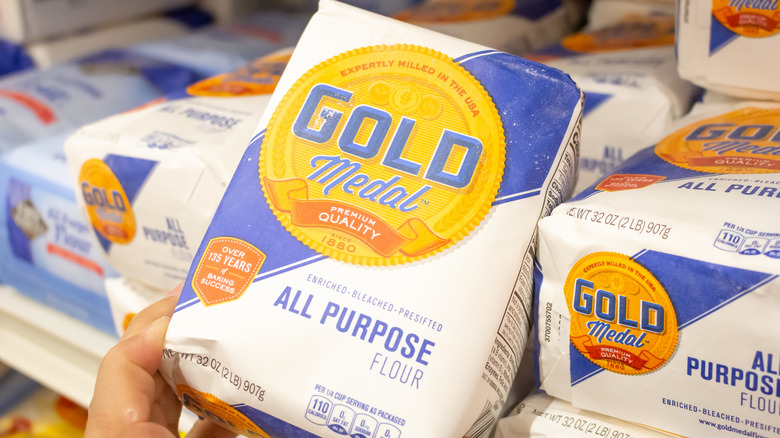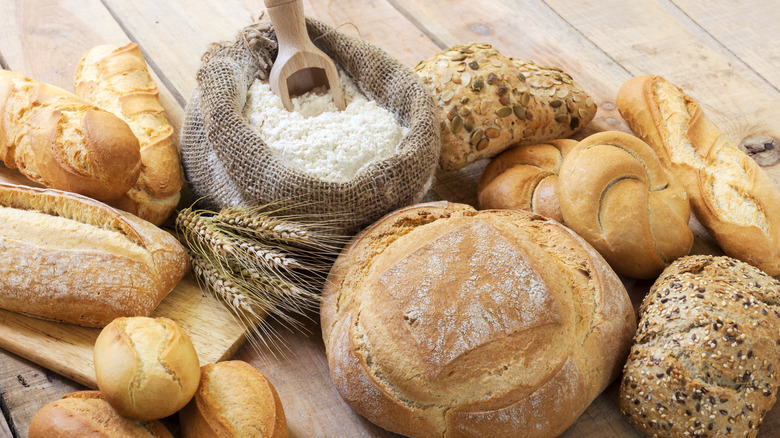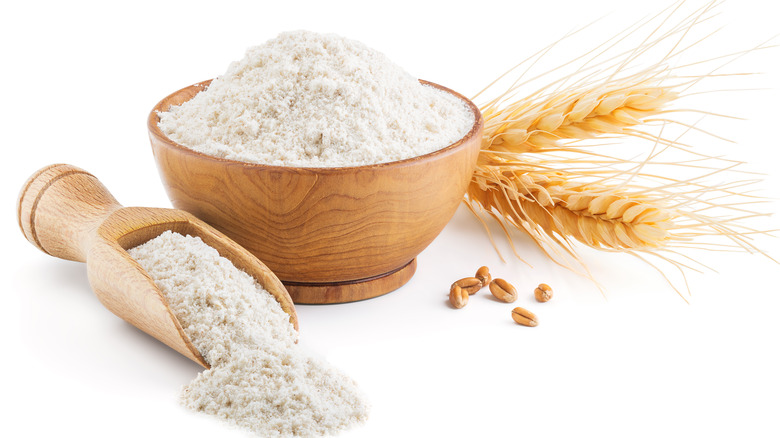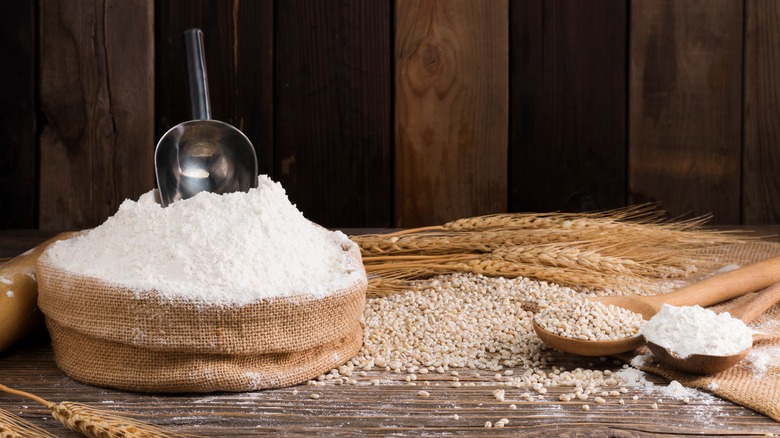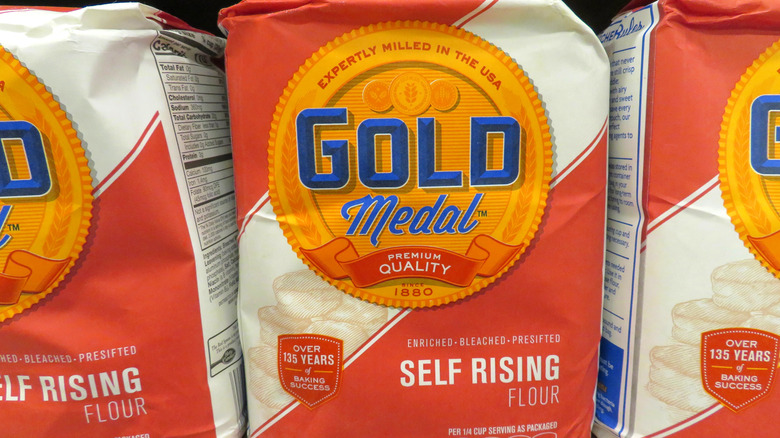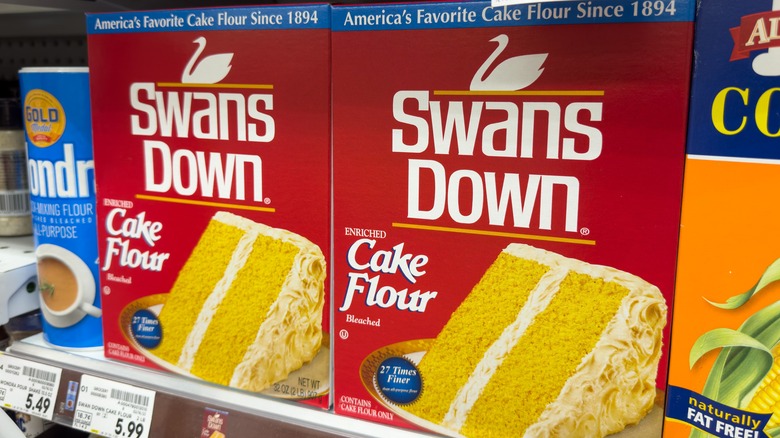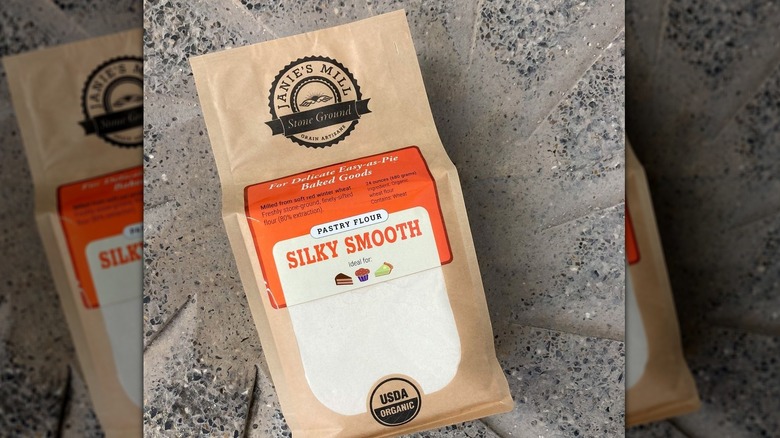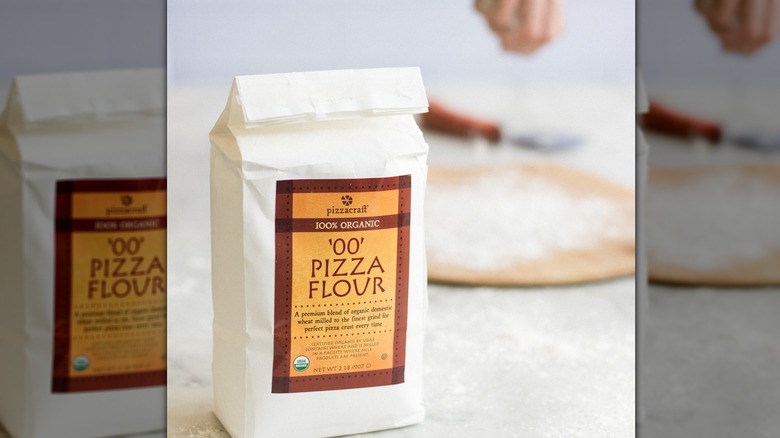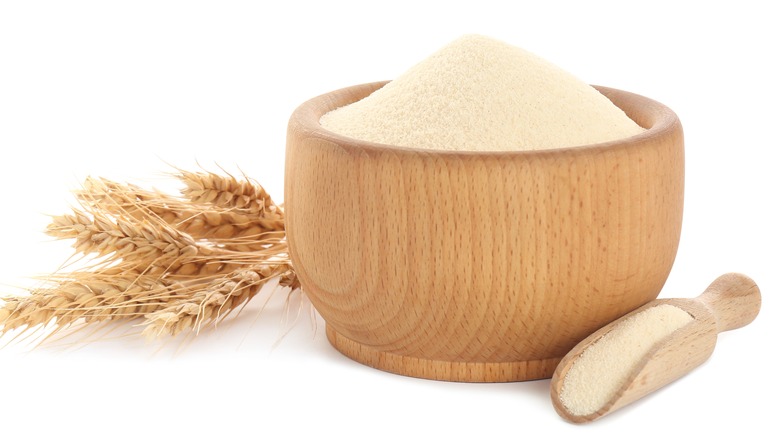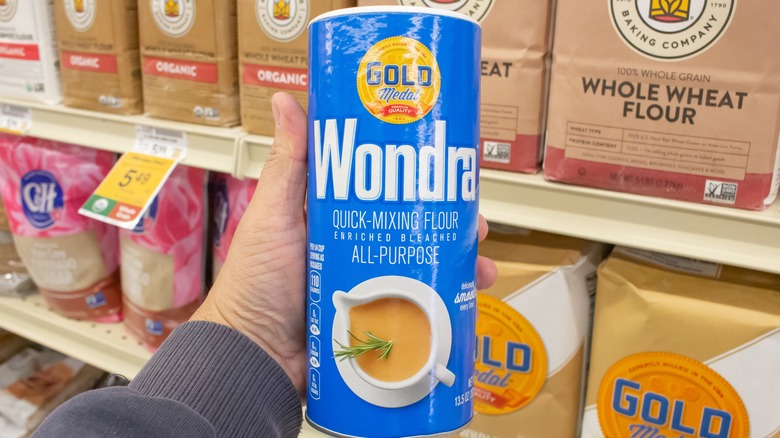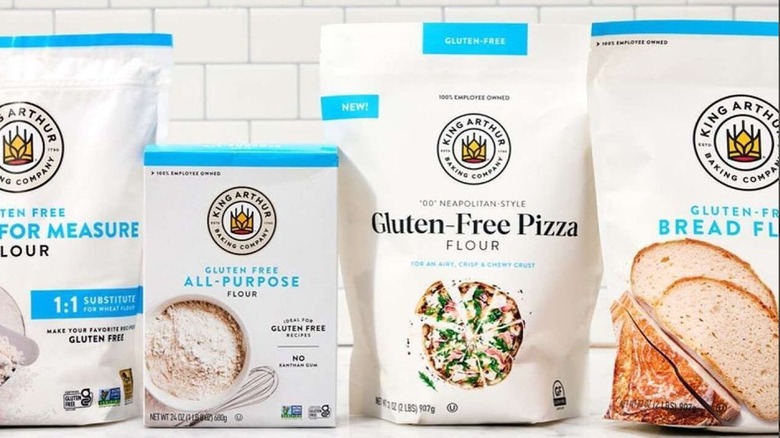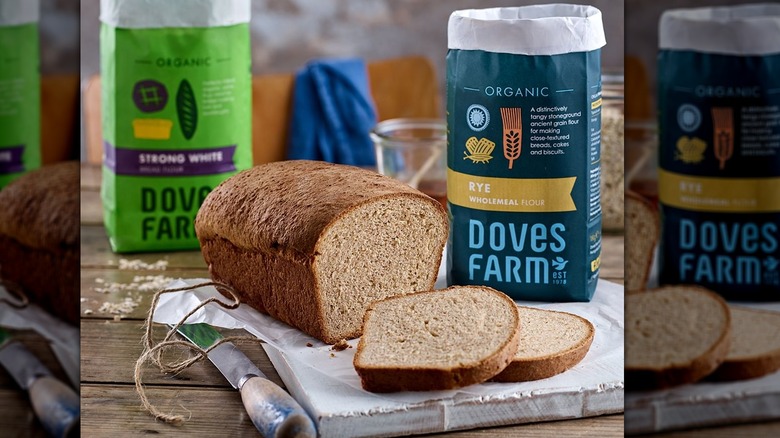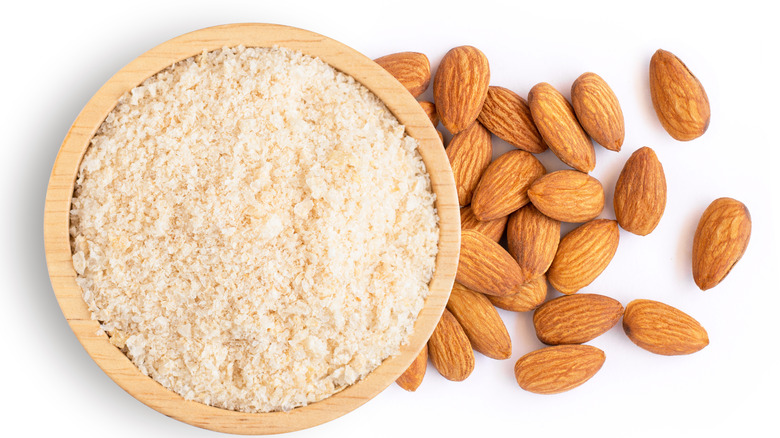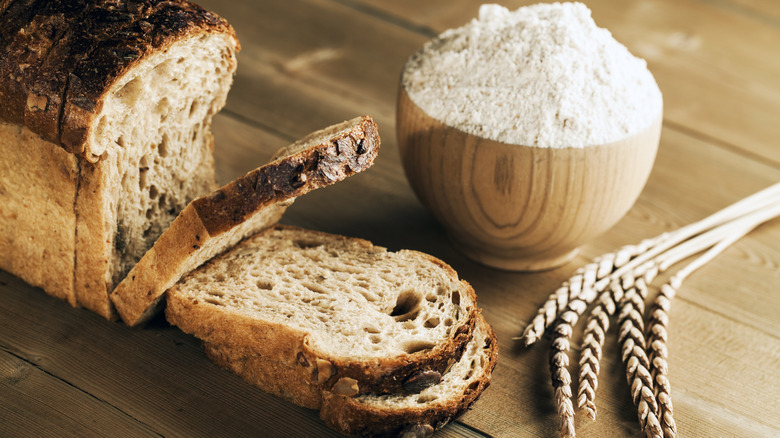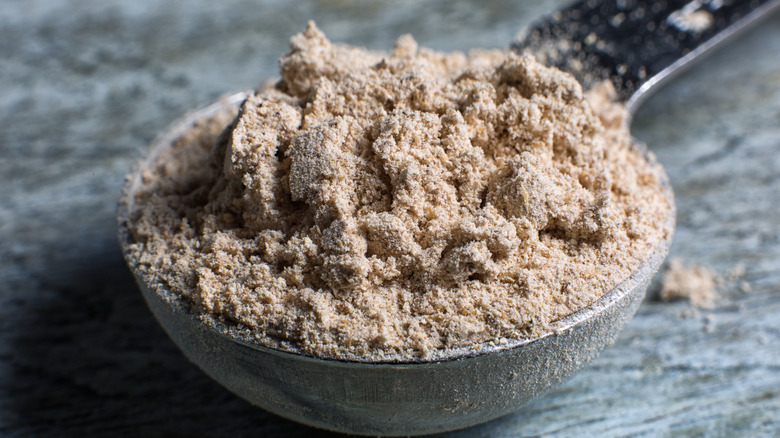15 Types Of Flour And How To Use Them
Gone are the days when you'd casually grab a sack of all-purpose flour from the grocery store shelf. These days, there are no fewer than two dozen varieties of flour available. With this kind of selection, picking the correct one can feel like a veritable baking minefield. For instance, you may be asking yourself if you can substitute pastry flour for cake flour when making grandma's prized angel food cake (you can, but you might be disappointed by the dense results).
Or you might be wondering what the difference is between bleached and unbleached flour. The quick answer is that all flours are bleached. But bleached flour uses chemicals to speed up the aging process, whereas unbleached flour ages naturally. As a result, treats made with bleached flour tend to be fluffier, richer, and more tender than those made with the unbleached variety. Still feeling lost? Then make sure to read this guide to types of flour and how to use them. We can't promise to solve all of your baking woes, but we'll do our best to answer your burning questions.
1. All-purpose flour
If you only have one type of flour at home, it's probably the all-purpose variety. This flour is made by stripping the bran and germ from the wheat, leaving behind the endosperm. True to its name, all-purpose flour can be used in a variety of recipes including cookies, muffins, and quick breads. It's also handy to keep around as a sauce thickener. It's so versatile because it contains a blend of strong and weak flours. Without getting too detailed, strong flour contains a lot of protein (and therefore gluten), making it well-suited for pasta and crusty bread. Weak flours are lower in protein and gluten, meaning they're a good match for delicate cakes and pastries.
By combining different strength flours, you end up with all-purpose flour, a middle-of-the-road baking staple with 10% to 12% protein. But just because you can use all-purpose flour in a lot of recipes doesn't mean you should. For instance, it lacks the heft needed to create chewy bread and the fineness to make lighter-than-air cakes. If all you've got at home is all-purpose flour, we recommend sticking to recipes that call for it, such as these coconut chocolate chip cookies.
2. Bread flour
Bread flour is made from hard red spring wheat. As a result, it contains more protein than other types of flour (about 11% to 14% on average). That's compared to the 10% to 12% you'll find in all-purpose flour. This difference may seem minor, but a few percentage points mean a huge difference in texture. To understand why, we have to look at the relationship between protein content and gluten. Higher protein flours develop more gluten, the protein responsible for giving baked goods their structure and chewiness.
As one of the highest protein flours on the market, bread flour is ideal for making pizza dough, soft pretzels, and pull-apart milk bread. Another trait of this gluten-heavy flour is that it gives baked goods elasticity and rise. Bread flour definitely has its advantages, but don't rely on the flour to do the work for you. Kneading the dough is an essential step in creating the gluten structure, so make sure to work the dough before baking for the best results.
3. Whole wheat flour
In order to understand whole wheat flour, it's important to know more about wheat. Wheat grows in three-part kernels made up of the endosperm, germ, and bran. The germ and bran are removed when making white flour, leaving only the endosperm to be milled into flour. Whole wheat flour, which is typically made from red wheat, contains some parts of the germ and bran. As a result, it is darker in color than all-purpose flour. It also has a slightly nutty flavor and dense texture you won't find in other varieties of white flour. What's more, wheat flour contains high amounts of fiber, iron, protein, and phosphorus.
It goes without saying that whole wheat flour is significantly healthier than white flour. Knowing that you might be tempted to ditch white flour completely. But don't go swapping whole wheat flour for all-purpose flour without a strategy in place. Whole wheat flour contains up to 15% protein, whereas all-purpose contains 10% to 12%. This makes wheat flour well-suited for use in Irish brown soda bread, bagels, and pizza crusts, but not so great in delicate cakes and pastries.
4. White whole wheat flour
The name white whole wheat flour is confusing. Is it white flour or is it wheat flour? Is it the product of mixing white and wheat flour together? Is it bleached or processed in some way? There's definitely a lot to know about this type of flour, but the answers to these questions are a lot simpler than you might think.
As its name suggests, white whole wheat flour is whole wheat flour. That means it contains all three parts of the wheat kernel (endosperm, germ, and bran). White refers to the type of wheat used and has nothing to do with white flour (it's also not bleached or processed in any way). Whereas whole wheat flour is made from hard red spring or winter wheat, white whole wheat flour is made from hard white spring or winter wheat.
Nutritionally speaking, the two wheat varieties are identical. They differ only in color and flavor. Basically, white whole wheat flour has a milder flavor and a lighter in color than whole wheat flour. Because they're so similar, you can use white whole wheat flour as a 1-to-1 substitute for whole wheat flour when making bread, pizza crust, and pancakes. If you're looking to substitute all-purpose flour for white whole wheat flour, then use 50% of the amount of flour. You might notice a slight color difference, but the flavor and texture will be the same. So, why not try it in these homemade English muffins?
5. Self-rising flour
Self-rising flour may seem like some kind of sorcery, but there's no magic here. This variety is just a mixture of finely milled flour and a leavening agent (aka baking soda and salt). You can find it in supermarkets, or you can make your own by combining all-purpose flour with 1½ teaspoons of baking powder and ½ teaspoon of salt. Depending on the type of flour you use, the protein content will be around 9%, this, plus the leavening agents, make self-rising flour for scones or fluffy Southern biscuits.
If you're used to incorporating leaveners separately, you might not see the benefit of keeping an additional flour variety stocked in the pantry. And you're right, you can absolutely get away with never buying self-rising flour. At most, this pre-made variety will save a few seconds. Another thing to consider is that you can't swap self-rising flour for other varieties because of the added baking powder and salt.
6. Cake flour
Cake flour is a delicate flour made from soft white wheat and soft red winter wheat. After milling, the flour is sifted for a fine texture. It contains between 5% to 8% protein. With less protein comes less gluten-forming potential. This is ideal when baking items that call for a soft, fluffy texture like angel food cake, snickerdoodles, or shortbread cookies.
Another advantage of using cake flour is that it absorbs liquids and sugar better than other varieties of flour. The result? Super moist cakes that stay that way until the last bite. There are plenty of benefits to using cake flour, but you can use all-purpose if that's all you've got. Just be aware that cakes and cookies made with all-purpose flour will have a coarser crumb than those made with cake flour. Alternatively, you can make your own cake flour at home. Just measure one cup of all-purpose flour, remove two tablespoons, and mix in two tablespoons of cornstarch.
7. Pastry flour
In between versatile all-purpose flour and cake flour, there's pastry flour. This variety is made from either soft white wheat or soft red winter wheat. With a protein content of around 9%, pastry flour is ideal when you're in the mood to whip up flaky, tender baked goods like pastries, pie crusts, and malawach, a buttery flatbread. Even though pastry flour is designed to give Danishes and croissants a soft, tender texture, you've got to take care when using it. More specifically, you can't overmix it. Stirring or mixing pastry flour dough for too long causes more gluten to develop, resulting in chewy, dense treats.
While pastry flour is certainly handy to have around, it's by no means necessary. Unless you're competing in a croissant competition or something, you can easily substitute cake flour for pastry flour and vice versa. However, if you want to be more precise, you can make your own pastry flour at home. To do so, combine ½ cup of all-purpose flour with ½ cup of cake flour. This mixture is more or less equivalent to one cup of pastry flour.
8. Double zero flour/00 flour
No one would blame you for not knowing about double zero flour (sometimes written as 00 flour). While common in its home country of Italy, you'll have to scour the shelves of a specialty Italian market or order it online if you're in the United States. It's a shame that this flour variety isn't more readily available because it makes for some dynamite homemade pizza crusts and pasta. This flour is well-suited for Italian dishes because of its texture and composition. Made from soft wheat, 00 flour (also called pizza flour or tipo 00) has an extra-fine texture similar to baby powder.
Compared to other flours, double zero is high in protein but low in gluten. This balance means that dough made from 00 flour is sturdy and elastic. Translation? It's easy to work with, whether you're making Neapolitan-style pizza or tagliatelle with wild mushrooms. At the same time, the final products have an airy, delicate texture that makes each bite more satisfying than the last. If you can't find 00 flour, feel free to use all-purpose instead. Making the switch won't ruin your recipes, although you might notice a slight texture difference if you've eaten a lot of authentic Italian food.
9. Semolina flour
Most of the flours you're familiar with are made from hard or soft red or white wheat, but semolina flour is made from durum wheat. Durum is the hardest type of wheat. As a result, its flour is high in protein and gluten. These features make semolina flour stretchy and well-suited for making eggless pasta. It also helps pasta keep its shape during the cooking process. In addition to its stretchiness, semolina flour has a gritty texture that acts as a barrier between homemade pizza dough and the pan.
Semolina flour is definitely a staple in Italian cooking, but you'll find it in lots of other cuisines. For example, couscous made with semolina is a staple food in Africa and the Middle East. In Nigeria, you'll find boiled semolina paired with soups and stews. And in Europe and India, semolina is the main ingredient in sweet puddings and porridges.
10. Instant flour
Often referred to by its brand name, Wondra, instant flour is a finely-milled, low-protein flour made from a mixture of wheat flour, iron, and B vitamins. It differs from other flours in that it undergoes a process called pregelatinization. All that means is that the flour undergoes a pre-cooking and drying process before packaging. The resulting product dissolves quickly and resists clumping when hot.
For that reason, instant flour is essential when making gravies, soups, sauces, and pie crusts. Rumor has it that Julia Child used this famed flour to make tender crepes. It also works wonders as a breading for pan-seared fish. A small sprinkle of instant flour is all you need to create a light, crispy crust even celebrity chefs would be impressed with. Instant flour works well as a coating because it binds to the surface of the fish evenly, something regular flour just can't do.
11. Gluten-free flour
If gluten is your kryptonite, then gluten-free flour is the antidote. These days, you'll find all kinds of gluten-free flour blends on the market. Some, like gluten-free all-purpose flour or gluten-free bread flour, aim to replicate common types of flour, while others, like almond or potato, are naturally gluten-free. For the purpose of this article, we're focusing on the former. However, if you're interested in exploring other types of flour, be sure to check out these types of gluten-free flour.
Each manufacturer is different, but in general, gluten-free flour is made with ingredients like rice flour, sorghum flour, potato starch, and xanthan gum. These blends are designed for everyday use in cooking and baking. We're big fans of using it in gluten-free lasagna, for example. Most products are formulated to be perfect cup-for-cup substitutes. However, that's not always the case. For that reason, it's always a good idea to check the packaging before filling up your measuring cup.
12. Rye flour
Thanks to its hearty nature, rye is a staple grain in the cold climates of Eastern Europe and Scandinavia. Once mature, rye kernels are milled to produce rye flour, an ingredient that gives a nutty, fruity flavor to baked goods. It also has an unmistakable sour flavor that ranges from mild to downright acidic. Put like that, rye flour doesn't sound all that appealing. But this underappreciated grain is essential when it comes to making rye bread, pie crusts, and even chocolate chip cookies.
If the flavor notes don't whet your appetite, then perhaps the health benefits will. Compared to wheat flour, rye flour is incredibly high in soluble fiber. In addition to keeping you fuller for longer, soluble fiber helps stave off constipation. It may also keep your blood sugar in check and help lower bad cholesterol (per Healthline). And while not completely devoid of gluten, rye flour has about three times less than wheat or barley flour, making it a potential option for those with mild gluten intolerances.
13. Almond flour
As you might have guessed, almond flour comes from ground almonds. Blanched almond flour is the most common type. It's made by boiling almonds, then removing their skins before grinding. The resulting flour has a fine texture and a pale color similar to parmesan cheese. You might also see it called almond powder or ground almonds. While less common, unblanched almond flour is also available. This variety is made by grinding whole almonds into a coarse powder. Depending on the brand of flour and the recipe you're following, almond flour can be used as a 1:1 gluten-free substitute for all-purpose flour.
That said, the lack of gluten in almond flour means that you have to take special care when using it. As an example, pizza crust made with almond flour only works when you add additional ingredients like baking powder, salt, eggs, and olive oil to the dough. Skip them and you'll end up with a crunchy, cracker-like crust. Similarly, you'll need to adapt your pie crust recipe when using almond flour. Almond flour crust works well as a pie base, but shouldn't be used as a top crust. Not only does the cracker-like texture resist bending, but almond flour dough browns quickly, something that could turn your masterpiece into a burnt mess.
14. Spelt flour
With a history dating back to 5,000 B.C., spelt has easily earned the ancient grain designation. First cultivated in Mesopotamia, this wheat species (which is related to farro) made its way through the Balkan Peninsula and the rest of Europe in the centuries that followed. Like many other types of flour, spelt comes in two varieties: whole grain and white. Like traditional whole wheat flour, whole grain spelt flour is made with all three parts of the plant (bran, endosperm, and germ). Unsurprisingly, the two flours share a similar texture and density, making them well-suited for Stollen bread, cookies, and muffins. White spelt is milled from just the endosperm, creating a light, slightly starchy flour. Both types have an acidic nutty flavor.
In most cases, you can use spelt flour as a 1-to-1 substitute for all-purpose or wheat flour. Indeed, it performs particularly well in cakes, crumbles, and cookies. When it comes to bread and pretzels that rely on rise, you'll have to experiment a bit before finding the correct proportions. We recommend replacing a quarter to half a cup of wheat flour with spelt flour, then adjusting the proportions as you go. We should also mention that doughs made with spelt flour require less kneading than you may be used to. In fact, over-kneading spelt dough could result in a crumbly final product.
15. Barley flour
Like rye, barley is an incredibly resistant crop. Not only can it resist the cold winters of northern Europe, but it's also drought tolerant. To make barley flour, this hearty grain is first cleaned, then roasted for improved flavor and color. Once roasted, the barley grains are ground up and sifted until flour is formed. Like many types of flour, you'll find several varieties of barley flour: whole, pearl, and hulled.
Whole barley flour uses all three parts of the grain (endosperm, germ, and bran). This makes whole barley the most nutritious of the three types. Pearl barley flour is made by removing the external husk and bran, the result of which is smooth flour with a mild flavor. Unfortunately, the trade-off is less fiber and minerals. Hulled barley keeps the bran, but removes the hull. Nutritionally speaking, it falls in the middle between whole and pearl barley flour.
Regardless of which type you choose, barley flour can be used to make multigrain bread, bagels, and crackers. It doesn't contain much gluten, so you'll want to use it in conjunction with another type of flour such as all-purpose or bread. Try substituting half of the what flour for barley flour. Alternatively, you can experiment with it when making unleavened flat bread.
Static Media owns and operates Tasting Table and Mashed.

